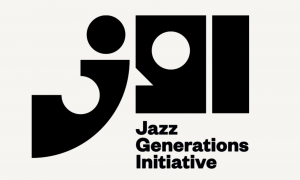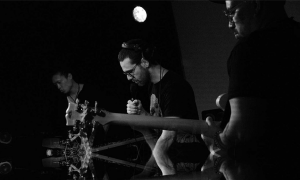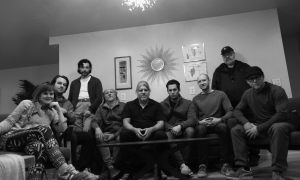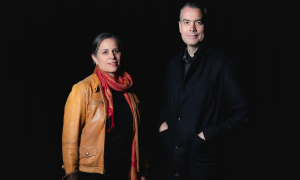
"Musicians are quick to recognize pretentions or falsehoods, but such attributes are never mentioned in Quincy's connection. Only admiration, and a certain amazement as to what he achieved, are the standard reactions." --Brian Priestley, liner notes
It didn't make sense economically, didn't make sense logistically, didn't provide ego satisfaction for star players, but Quincy Jones formed a big band. For the sheer sake of the music.
And because of their love for Quincy, an exceptional group of musicians signed on for the “tour," some of them literally traipsing all over Europe to find venues that could house them and bandstands that could squeeze them all in. There was never any problem finding audiences eager to hear what Quincy was thinking, or what musicians like Art Farmer, Zoot Sims, Curtis Fuller, Phil Woods, Freddie Hubbard, Benny Golson, Art Blakey, and Hank Jones were blowing. And listeners today will discover just the same joy.
The set includes all of his 1959-60 studio and 1961 live Mercury sessions, as well as an earlier set from 1956 for ABC-Paramount and a 1961 date for Impulse. The 1956 date for an ABC-Paramount release was a masterpiece of arranging and band leading. You hear him creating his new sound in what is the core of the set, the 1959-60 studio recording that comprised Quincy's “The Birth of a Band" release and later sessions. The final dates were a reunion of sorts, for a tour in Europe and a performance at Newport and an expanded orchestra for a studio session on Impulse. Even though recordings spanned a number of years, from New York to Zurich to Paris to Newport and back to New York, we were able to track down every original tape master.
In writing for the big band, Quincy concealed a great deal of harmonic and rhythmic complexity in his charts. He really was reinventing big band music for a new decade and a new generation of listeners. His pieces sounded youthful and vibrant, and could be technically demanding almost beyond belief; more the writing you'd expect a five-piece band to conquer, not one comprising 17 or 18 or 20 musicians. But his bands rose to the challenge, showing there is great swing in precision, and a way of creating excitement by playing both loose and tight at the same time.
The over-brimming talent of Quincy Jones was recognized early. Raised in Seattle, Quincy first began to study trumpet as a teen, and within a few years was performing, touring and recording. He also quickly took to arranging, creating charts for Oscar Pettiford, Art Farmer, Tommy Dorsey, and Count Basie, among others, just six or seven years after taking up the horn. Work as a music director, producer, and conductor came soon after and he would become a record company executive at a time when black musicians didn't get those opportunities.
The set includes an essay by Brian Priestley and a complete discography, as well as many rare photographs by Chuck Stewart. But what it mostly contains is a fountain of youthfulness, in an unlikely, illogical, unprecedented and entirely delightful way that could only belong to Quincy Jones.
It didn't make sense economically, didn't make sense logistically, didn't provide ego satisfaction for star players, but Quincy Jones formed a big band. For the sheer sake of the music.
And because of their love for Quincy, an exceptional group of musicians signed on for the “tour," some of them literally traipsing all over Europe to find venues that could house them and bandstands that could squeeze them all in. There was never any problem finding audiences eager to hear what Quincy was thinking, or what musicians like Art Farmer, Zoot Sims, Curtis Fuller, Phil Woods, Freddie Hubbard, Benny Golson, Art Blakey, and Hank Jones were blowing. And listeners today will discover just the same joy.
The set includes all of his 1959-60 studio and 1961 live Mercury sessions, as well as an earlier set from 1956 for ABC-Paramount and a 1961 date for Impulse. The 1956 date for an ABC-Paramount release was a masterpiece of arranging and band leading. You hear him creating his new sound in what is the core of the set, the 1959-60 studio recording that comprised Quincy's “The Birth of a Band" release and later sessions. The final dates were a reunion of sorts, for a tour in Europe and a performance at Newport and an expanded orchestra for a studio session on Impulse. Even though recordings spanned a number of years, from New York to Zurich to Paris to Newport and back to New York, we were able to track down every original tape master.
In writing for the big band, Quincy concealed a great deal of harmonic and rhythmic complexity in his charts. He really was reinventing big band music for a new decade and a new generation of listeners. His pieces sounded youthful and vibrant, and could be technically demanding almost beyond belief; more the writing you'd expect a five-piece band to conquer, not one comprising 17 or 18 or 20 musicians. But his bands rose to the challenge, showing there is great swing in precision, and a way of creating excitement by playing both loose and tight at the same time.
The over-brimming talent of Quincy Jones was recognized early. Raised in Seattle, Quincy first began to study trumpet as a teen, and within a few years was performing, touring and recording. He also quickly took to arranging, creating charts for Oscar Pettiford, Art Farmer, Tommy Dorsey, and Count Basie, among others, just six or seven years after taking up the horn. Work as a music director, producer, and conductor came soon after and he would become a record company executive at a time when black musicians didn't get those opportunities.
The set includes an essay by Brian Priestley and a complete discography, as well as many rare photographs by Chuck Stewart. But what it mostly contains is a fountain of youthfulness, in an unlikely, illogical, unprecedented and entirely delightful way that could only belong to Quincy Jones.
For more information contact All About Jazz.


































